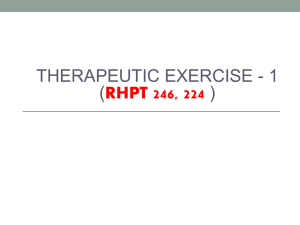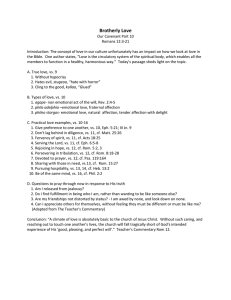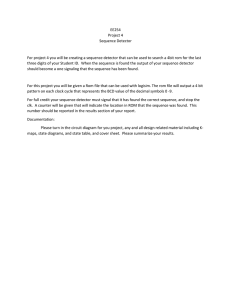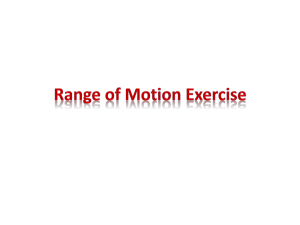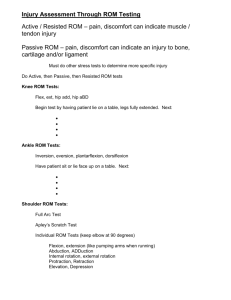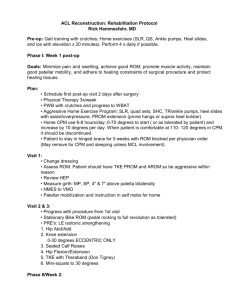Document 15364245
advertisement
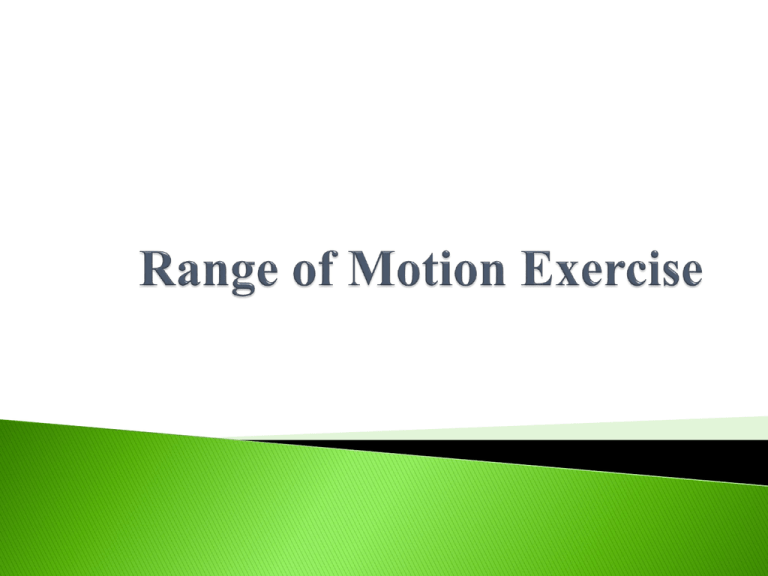
basic technique used for the examination of movement and for initiating movement into a program of therapeutic intervention The structure of the joints, as well as the integrity and flexibility of the soft tissues that pass over the joints, affects the amount of motion that can occur between any two bones. all structures are affected by ROM To describe joint range flex. Ext. … ◦ measured with a goniometer and recorded in degrees. Muscle range functional excursion of muscles. ◦ the distance a muscle is capable of shortening after it has been elongated to its maximum. ◦ directly influenced by the joint it crosses one-joint muscles v.s. two-joint muscles two-joint muscles shortens to a point known as active insufficiency, where it can shorten no more. when fully elongated it is in a position known as passive insufficiency. To maintain normal ROM, the segments must be moved through their available ranges periodically factors can lead to decreased ROM ◦ systemic, joint, neurological, or muscular diseases ◦ surgical or traumatic insults ◦ inactivity or immobilization for any reason. ROM activities are administered to maintain joint and soft tissue mobility to minimize loss of tissue flexibility and contracture formation. Passive ROM. ◦ movement of a segment within the unrestricted ROM that is produced entirely by an external force Active ROM. ◦ movement of a segment within the unrestricted ROM that is produced by active contraction of the muscles crossing that joint. Active-Assistive ROM. ◦ assistance is provided manually or mechanically by an outside force because the prime mover muscles need assistance to complete the motion. Regions of acute, inflamed tissue Patient unable to or not supposed to actively move a body segments ◦ comatose, paralyzed, or on complete bed rest decrease the complications that would occur with immobilization ◦ cartilage degeneration, adhesion and contracture formation, and sluggish circulation. Maintain joint and connective tissue mobility Minimize the effects of the formation of contractures Maintain mechanical elasticity of muscle Assist circulation and vascular dynamics Enhance synovial movement for cartilage nutrition Decrease or inhibit pain Assist with the healing process after injury or surgery Help maintain the patient's awareness of movement When a examining inert structures, PROM is used to determine limitations of motion, to determine joint stability, and to determine muscle and other soft tissue elasticity. When a teaching an active exercise program, PROM is used to demonstrate the desired motion. When a therapist is preparing a patient for stretching, PROM is often used preceding the passive stretching techniques. patient able to contract the muscles actively and move a segment with or without assistance patient has weak musculature and is unable to move a joint through the desired range (usually against gravity) aerobic conditioning programs on the regions above and below the immobilized segment same goals of PROM can be met with AROM ◦ Maintain physiological elasticity and contractility of the participating muscles ◦ Provide sensory feedback from the contracting muscles ◦ Provide a stimulus for bone and joint tissue integrity ◦ Increase circulation and prevent thrombus formation ◦ Develop coordination and motor skills for functional activities Passive motion does not: ◦ Prevent muscle atrophy ◦ Increase strength or endurance ◦ Assist circulation to the extent that active, voluntary muscle contraction does For strong muscles, active ROM does not maintain or increase strength. It also does not develop skill or coordination except in the movement patterns used. when motion to a part is disruptive to the healing process Historically, ROM has been contraindicated immediately after acute tears, fractures, and surgery; but ... stays within the range, speed, and tolerance of the patient during the acute recovery stage Signs of too much or the wrong motion include increased pain and increased inflammation ROM should not be done when patient response or the condition is life-threatening. PROM may be carefully initiated to major joints and AROM to ankles and feet to minimize venous stasis and thrombus formation. After myocardial infarction, coronary artery bypass surgery, or percutaneous transluminal coronary angioplasty, AROM of upper extremities and limited walking are usually tolerated under careful monitoring of symptoms. Examination, Evaluation, and Treatment Planning ◦ Examine and evaluate the patient's impairments and level of function, determine any precautions and prognosis, and plan the intervention. ◦ Determine the ability of the patient to participate in the ROM activity and whether PROM, AAROM, or AROM can meet the immediate goals. ◦ Determine the amount of motion that can be safely applied for the condition of the tissues and health of the individual. Decide what patterns can best meet the goals ◦ Anatomic planes of motion: frontal, sagittal, transverse ◦ Muscle range of elongation: antagonistic to the line of pull of the muscle ◦ Combined patterns: diagonal motions or movements that incorporate several planes of motion ◦ Functional patterns: motions used in activities of daily living (ADL) Monitor the patient's general condition and responses during and after the examination and intervention Document and communicate Re-evaluate and modify the intervention as necessary. Communicate with the patient. Free the region from restrictive clothing, linen, splints, and dressings Position the patient in a comfortable position with proper body alignment and stabilization Position yourself so proper body mechanics can be used To control movement, grasp the extremity around the joints. Support areas of poor structural integrity Move the segment through its complete pain-free range to the point of tissue resistance. Perform the motions smoothly and rhythmically, with 5 to 10 repetitions. During PROM the force for movement is external, being provided by a therapist or mechanical device. No active resistance or assistance is given by the patient's muscles that cross the joint. The motion is carried out within the free ROM Demonstrate the motion desired using PROM; then ask the patient to perform the motion. Provide assistance only as needed for smooth motion. When there is weakness, assistance may be required only at the beginning or the end of the ROM, or when the effect of gravity has the greatest moment arm The motion is performed within the available ROM.
